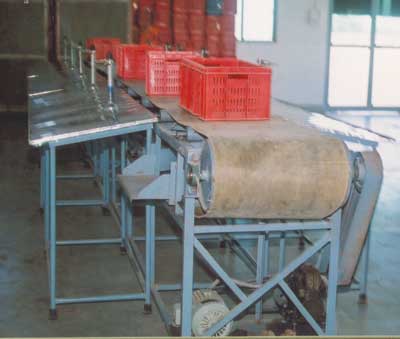Ramdas Madhavrao Jagtap (51) hails from Jopul village, Nashik, Maharashtra. His father was a carpenter but Jagtap was not interested in carpentry, so he set up his own welding workshop in 1969-1970. He makes farm machinery, bullock carts and other such equipment. Though educated up to only the eleventh standard, he ensured that his sons got the right education. His eldest son has completed his post graduation in Inorganic Chemistry and is a school teacher. Two other sons are engineers in the Chemical and Mechanical disciplines. The youngest is studying computer engineering.
Genesis
Ramdas belongs to Nasik District, which is a major centre of grape production. A few years ago, some farmers approached him with a request to develop a machine to separate stalks from dry grapes and also grade them into different quality raisins. Till then, this was mostly done manually.
Grading of raisins involves sorting raisins by size, mainly for exports. To produce raisins, bunches of grapes are first brought from the vineyards to the raisin-manufacturing units, called ‘sheds’. There they are processed according to the variety of raisins to be manufactured. The green coloured raisin Hirwa and yellow coloured raisin Pivla are two of the major grades manufactured in the region of Maharashtra. Hirwa grade is mainly manufactured for export and Pivla is for sale in the domestic market.
These raisins need further processing – cleaning, removal of debris, and grading into various sizes. Conventionally, this was done manually by women who worked for minimum wages. The grading was done by them based on visual inspection.
To find a solution, Ramdas spent two years using the principle of the thresher for grading but this proved to be unsuccessful. The main reason was that there is a marked difference in the weight of grain and debris compared to the difference in weight of raisins and debris, which is much less. So with his knowledge and experience with tools and machines he developed a machine in 1993 that would cater to the grape farmers’ requirements.
However, there were a number of shortcomings that took time to rectify. One problem with the first design was that because of excessive beating in the machine, the sugar would secrete out when the raisins were kept in cold storage and thus the sugar content was reduced. This spoilt the quality of the raisins. Ramdas made a few changes and within a year came up with a modified design. Another problem he faced was that the blower was picking raisins along with the debris. So he reduced the diameter of the impeller and this reduced the intensity of the vacuum and thus the raisins were not picked along. Slowly the grape farmers got to know of this machine. After studying it, they realized that this machine was easy to use and very efficient and began placing orders with Ramdas.
This is a single unit that removes dust and twigs and grades raisins by size. The machine consists of three motors and three sieves, blower, a belt and pulley mechanism and a rubber brush.
The grapes are dried for 15 – 20 days and then treated with chemicals to ensure proper drying and protection from pests. The dried grapes are fed into the machine through a feeder, which has a rotor with a rubber brush. A 3 HP motor drives the mechanism. The brush hammers the dried grapes to get the small twigs off the grapes. These dried grapes are then passed through the blower, which blows the dust off them and cleans the grapes with the help of a high-pressure airflow. The blower utilizes the power of a 2 HP motor. The dried grapes are now clean and are graded with a vibrator (driven by a 2 HP motor) connected to three sieves with different wire meshing (9 mm, 6 mm and 4 mm). These are connected through a pulley-belt drive. The dried grapes separated over each sieve are collected in a different chamber after they are scaled in specific grades. These are then finally processed accordingly for making raisins (kishmish). The machine grades the raisins into three sizes – large, medium, and small.
There are two models of the machine- the smaller model grades about two tons of raisins in 12 hours and the bigger model grades four tons in the same period. The machines weighs 600 kg and 1000 kg respectively. The smaller machine costs Rs.30, 000 and the bigger machine costs Rs.45, 000.
Advantages
Traditionally, grading required a lot of time and energy and was done manually. This machine saves time by blowing away the dust, removing the twigs and grading the raisins by size. This simplifies the entire process for the farmer and after the raisins are graded, the farmer visually inspects the quality. With this device, the operator is safe from exposure to the dust from the blower. This machine helps in removing the tediousness involved in cleaning every single raisin and grading it accordingly.
The other comparable machine is imported and costs around Rs.20,00,000. It grades grapes according to their colour, size, shape etc. The cost advantage is overwhelming in the case of Jagtap’s unit - it costs only about Rs.45,000 and gives satisfactory results compared to the imported machine- and this could become an important factor in users’ choice of equipment.
Current Status
Ramdas Jagtap has been working on this machine for more than a decade and has been selling it to local grape farmers in the Satara, Sangli, Sholapur regions of Maharashtra as well as in Bijapur, Karnataka. One unit has also been installed at the manufacturing unit of ‘Rangoli’ raisins, one of the biggest raisin exporters of the region. So far, Ramdas has sold 25-30 small units and 40-50 big units. These machines have high diffusion potential in all major grape growing regions. Many prominent grape farmers of the area have brought this grading machine from him.
Generally farmers make some of the payment in advance when they order the machine, and the balance is paid when the machine is ready. Ramdas has employed a couple of labourers. He hires more when he has sufficient orders. He manufactures the machines in the months of November, December and January and sells them during February, March and April as the demand is seasonal.
At present, this machine is being used for raisins. It can also be used for grading of mangoes for making pickles and also for grading other fruits. Ramdas is not keen to patent the machine as this type of machine is already available in the market. His machine, though, incorporates additional features which farmers find useful. Further, since he has been selling this product for about ten years, the patent cannot be filed, as the component has come into the public domain.
A variety of similar machines are now available in the market following Ramdas’s innovation. Since then, three other fabricators have copied the design and are now supplying them to the major grape growing regions of Maharashtra, Andhra Pradesh and Tamil Nadu. However these manufacturers have also recognized the fact that the original machine was developed by Jagtap
Other contributions to the grape industry and laurels earned Ramdas has developed a machine that washes the dry grapes. He has also fabricated a conveyor belt for the valves of a grape packaging factory that facilitates movement of grapes from the primary house to the packing hall for the purpose of export. This is most useful for grape exports as the area for packaging is very small. By using this conveyor belt, within a short time period, a large number of boxes can be packed and the labour charges are also reduced. This has prompted several exporters of grapes to have the conveyor belt installed.
Jagtap was honoured by the National Research Centre for Grapes (Indian Council of Agricultural Research) for his contribution to grape production/ processing/ marketing on December 23, 2002 on the occasion of Kisan Diwas organized to mark the birth centenary of Lal Bahadur Shastri, former Prime Minister of India. Maharashtra Grape Growers’ Association, Pune, has also recognized his valuable contribution to the grape growers in Maharashtra. Jagtap has also received a few awards from the local community for this innovation.







